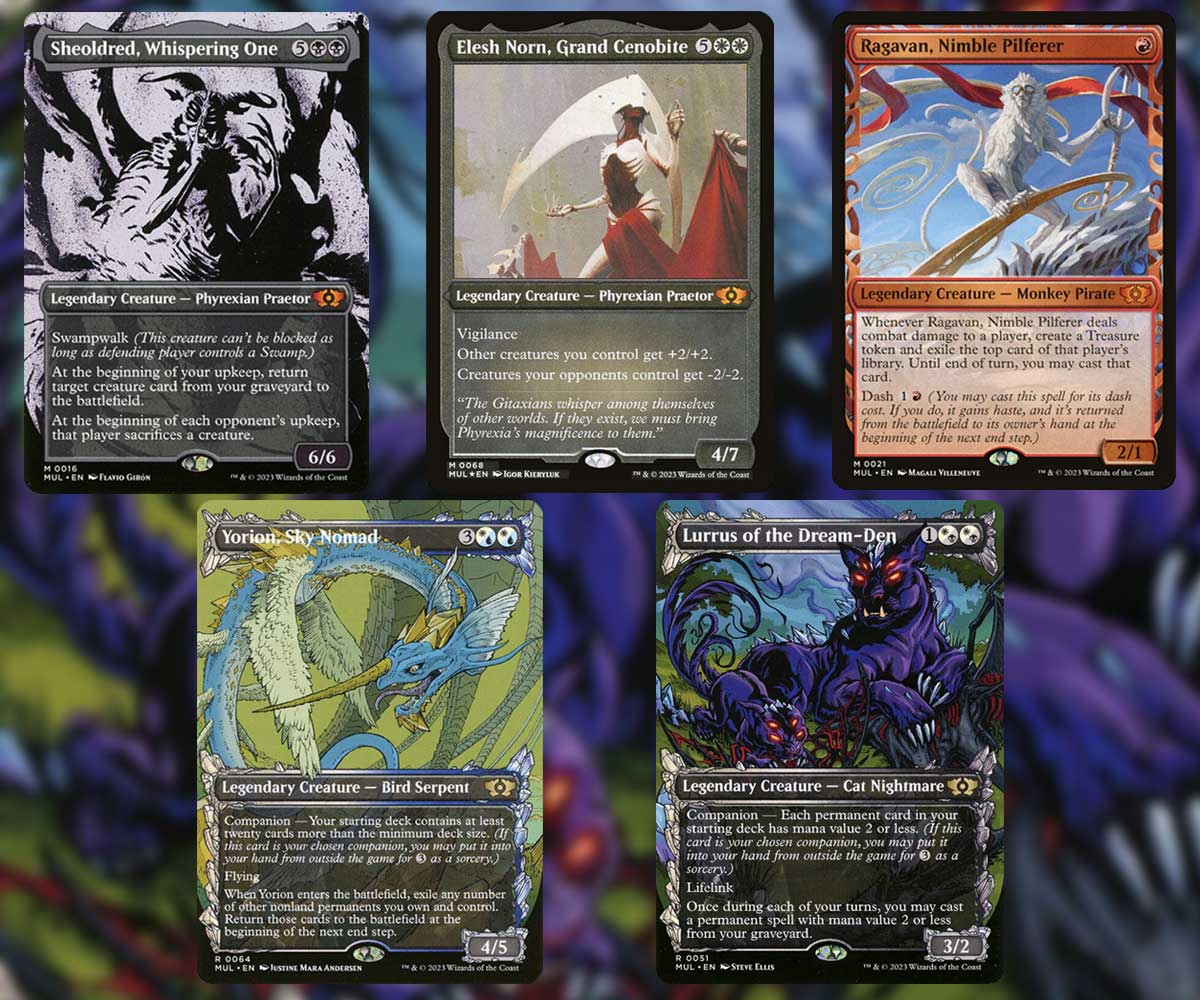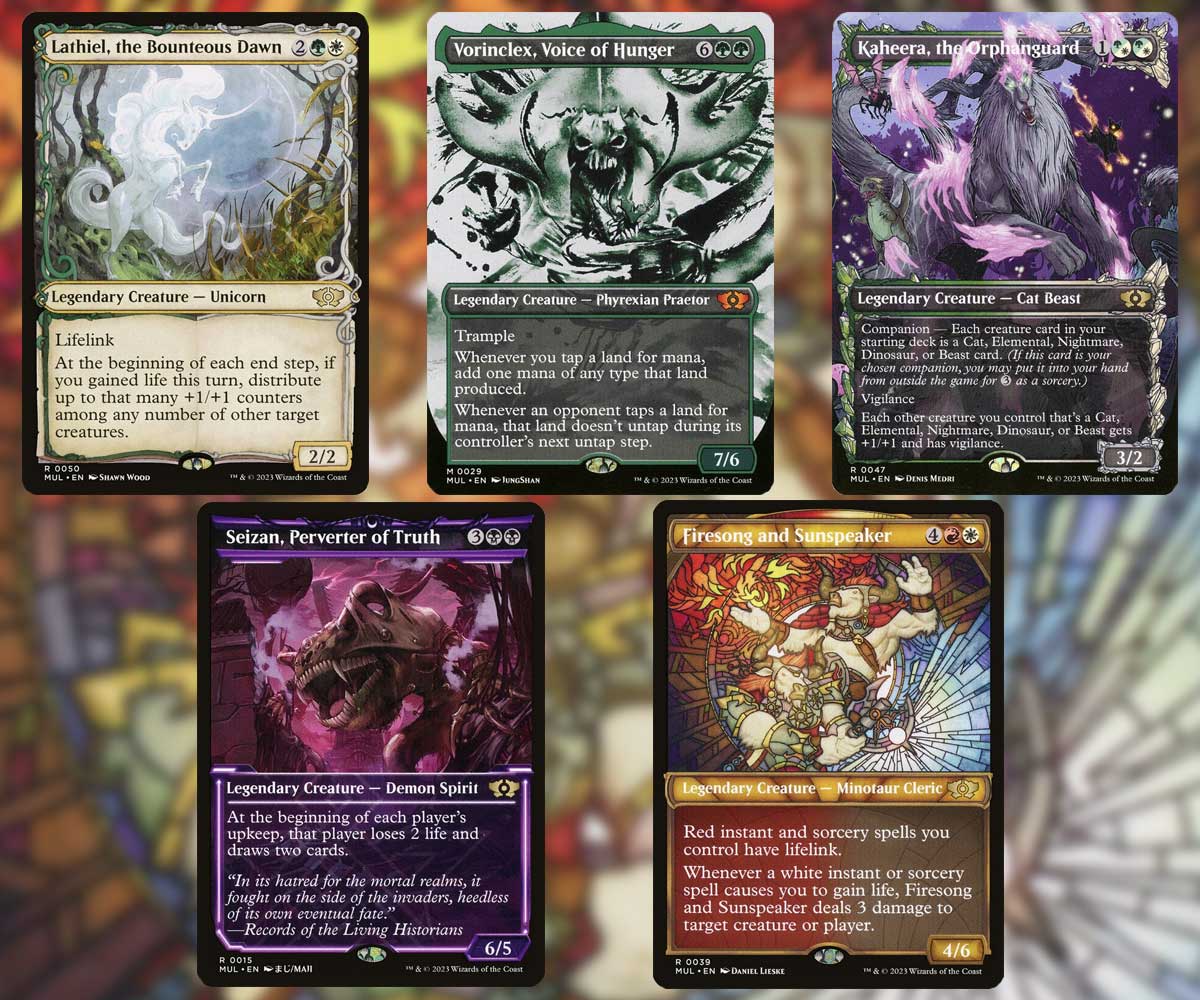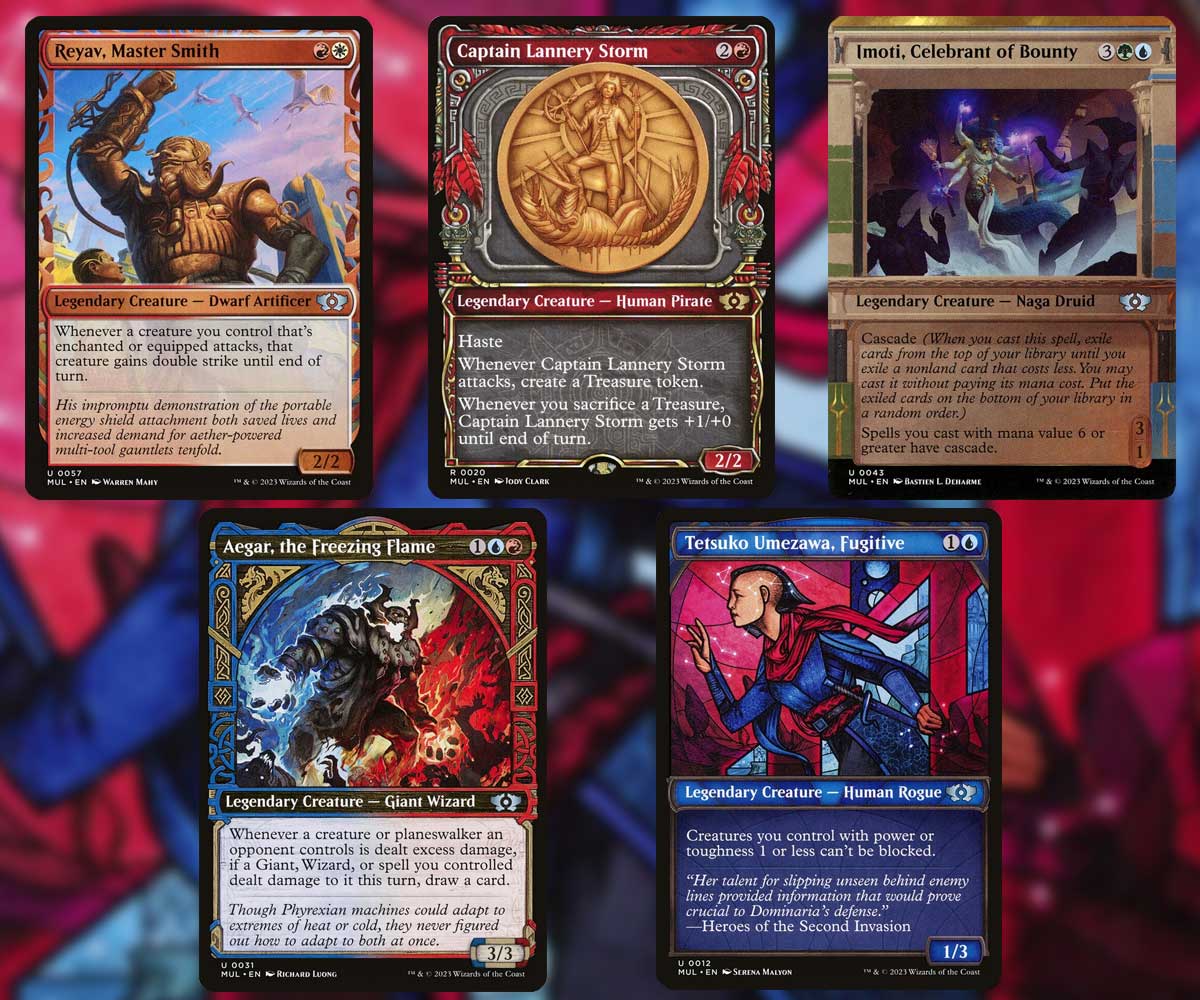Loading...
Products
Magic: The Gathering Line
March of the Machine Limited offers an exhilarating gameplay experience with an impressive depth, but mastering it can be a daunting task, especially with the addition of the Multiverse Legends. This set of cards, which is similar to the Mystical Archive of Strixhaven: School of Mages and the Retro Artifacts of The Brothers' War, features iconic characters from Magic’s history, and each draft booster contains one such Multiverse Legend.
Unfortunately, players are often tempted to pick popular Constructed all-stars that fail to synergize with the set, while undervaluing the more subtle cards that possess immense potential to win games. In this article, I will provide insights into which Multiverse Legends are truly Limited bombs, which ones are potential traps, and which ones are inconspicuous overperformers.

Elesh Norn, Grand Cenobite is one of the best cards in the set. When she enters the battlefield, she can decimate your opponent's board, often securing the game in your favor unless they can manage to find a removal spell. Consider a scenario where the battlefield is crowded with 3/3s on both sides. Elesh Norn, Grand Cenobite turns the tide by transforming your creatures into 5/5s while reducing your opponent's to mere 1/1s. It's like bringing a bazooka to a knife fight!
But that's not all. Elesh Norn is nearly untouchable by common removal spells. Her toughness is too great for Shatter the Source to handle, she has vigilance to avoid being Cut Short and even potential brawlers for Cosmic Hunger find themselves weakened in her presence. Elesh Norn not only looks like a bomb - she actually is a bomb.
While Sheoldred, Whispering One may not pack the same immediate punch as Elesh Norn, she still ranks high as a formidable force in Limited gameplay. If your opponent fails to remove her right away, they'll soon find themselves sacrificing a creature as soon as your turn ends. On each subsequent upkeep, the situation on the battlefield tilts further in your favor.
In a prolonged game, Sheoldred becomes virtually unbeatable when left unchecked. This makes her a true Limited bomb that demands an answer.
As a 4/5 flier with relevant abilities, Yorion, Sky Nomad is a bomb in your main deck, and I would first-pick it over every common or uncommon. Yorion’s hybrid cost makes it easy to fit into 70 percent of two-color combinations, making it more flexible than a monocolor pick. Moreover, Yorion's enters-the-battlefield ability offers unexpected utility in this format by resetting battles and granting you another opportunity to trigger their powerful enters-the-battlefield effects.
That being said, I recommend exercising caution before using Yorion as your companion. When companions were initially introduced in Ikoria: Lair of Behemoths, players could cast them directly from the companion zone, but a subsequent update added a three-mana tax to add it to your hand first, making it less desirable to fulfill the stipulation. In March of the Machine draft, it may be reasonable to use Yorion as your companion in pools with deep, flat power levels. However, in most cases, a 40-card deck will provide more consistency in drawing your best cards, and I would prefer that over a diluted 60-card configuration. In any case, Yorion will be one of your best cards.
Lurrus of the Dream-Den is not only a powerhouse in Constructed but also a top-tier card in Limited. With its hybrid cost, it's an excellent early pick that fits in most decks. In the main deck, Lurrus provides a great advantage by winning damage races and providing late-game stability. Fulfilling Lurrus' companion requirement is more challenging in Limited than in Constructed, but it can still be worth it.
If you aim to maximize Lurrus' potential as your companion, then prioritize one-drop and two-drop creatures, and keep an eye out for synergies between them. For example, when you back up one Enduring Bondwarden onto another Enduring Bondwarden and then sacrifice this creature to Dreg Recycler, then you get two instances of its death trigger, allowing you to put the counters on another creature twice. Additionally, consider picking up Urn of Godfire, which provides repetitive removal when paired with Lurrus, as well as spells like Angelic Intervention or Unseal the Necropolis to keep your companion in play. Overall, Lurrus is a potent card that can greatly enhance your Limited deck.
Ragavan, Nimble Pilferer is one of the most-played cards in Modern, where his unbridled shenanigans can quickly turn the tide of a game. However, in Limited, Ragavan's path to glory may not be as straightforward. With opponents fielding sizable blockers and cheap removal in short supply, Ragavan's ability to make an impact may be more Limited. But don't count him out just yet! Even a single successful attack from Ragavan can reap incredible rewards, making him a strong addition to any Limited deck.
Pair Ragavan with backup creatures like Redcap Heelslasher, Chomping Kavu, Bola Slinger or Golden-Scale Aeronaut, and it’ll be easy to set up multiple profitable attacks. And who knows, with the help of Astral Wingspan, Ragavan may finally achieve his long-held dream of taking to the skies. So don't hesitate to first-pick Ragavan over any common or uncommon and watch the chaos unfold!

Seizan, Perverter of Truth may seem imposing at first glance, with its impressive stats and ability to draw two cards every turn. However, when you play Seizan, your opponent will draw two cards before you do. This means that if they have a removal or bounce spell, they can quickly take out Seizan and leave you down two cards in the exchange. Even if it takes them a few turns to find a solution, they will always be ahead in terms of card advantage. In draft, Seizan is a trap.
While some of the Praetors are incredible in Limited, Vorinclex, Voice of Hunger falls short of the mark. I think most players understand that the 10-mana Jin Gitaxias, Core Augur is out of reach for most Limited games, but even Vorinclex’s 6GG cost is too steep for the meager reward it provides. Doubling your mana is irrelevant when Vorinclex is usually the last card in your hand. Additionally, depriving your opponent of their resources is not as crucial when they are running out of gas by turn eight. Most of the time, Vorinclex pales in comparison to Copper Host Crusher. To avoid disappointment, I suggest not selecting Vorinclex in draft.
Don't be fooled by Firesong and Sunspeaker’s flashy abilities. Its 4/6 body is nothing to write home about, and its supposed strengths are largely irrelevant in this set. Sure, you might gain a few points of life here and there with cards like Volcanic Spite or Shatter the Source, but that won't help you control the board or win the game. And while the ability to deal three damage is theoretically appealing, it's impossible to trigger in March of the Machine Limited since there are no white instant or sorcery spells that gain life. Sadly, Firesong and Sunspeaker will likely end up gathering dust in your sideboard.
While Lathiel, the Bounteous Dawn may seem like a powerhouse in March of the Machine Limited, the reality is that it can be quite difficult to trigger its ability. Sure, with common pump spells or life gain cards like Alabaster Host Sanctifier, Seed of Hope or Blossoming Sands, it is possible to gain the necessary life and trigger Lathiel at the end of turn. However, triggering Lathiel reliably is far from easy, and it runs the risk of being a mere 2/2 for four mana most of the time. Thus, while Lathiel can certainly run away with the game in the right circumstances, it is not a guaranteed bomb and should be approached with caution.
When it comes to companions in March of the Machine Limited, Kaheera, the Orphanguard seems to be the runt of the litter. While there are some common creatures like Wary Thespian, Bonded Herdbeast, War-Trained Slasher and Gloomfang Mauler that fit Kaheera's companion restriction, it's rare to draft more than a couple of them. As a result, it's nearly impossible to meet Kaheera's companion requirement. And if you end up playing her in your main deck, you'll often find yourself with a lackluster 3/2 vigilance creature with a minor ability that doesn't quite measure up to other three-drops. Additionally, Kaheera's casting cost makes it difficult to consistently cast her on turn three in any deck other than green-white. In short, Kaheera is a deceptive trap that's best left out of your draft strategy.

Although the red-white archetype in March of the Machine Limited emphasizes backup, the Multiverse Legends also enable a hidden Equipment deck. For example, if you can chain together Beamtown Beatstick into Reyav, Master Smith, you'll generate a quick and powerful clock that's difficult to stop. Surprisingly, decks built around Reyav can often outperform those built around Mirror-Shield Hoplite. Reyav is one of the strongest gold uncommons in the set and should not be underestimated.
In the absence of Wizards or Giants - Furnace Host Charger is the only high-power one at common - it might seem like triggering Aegar, the Freezing Flame will be difficult. However, you can still trigger him by double-blocking or using combat tricks, which makes Aegar a decent three-drop. For example, if your opponent attacks with a 4/3 creature while you have a 4/3 of your own and Aegar, you can double-block to deal excess damage and trigger Aegar's ability. Despite not being as flashy as some other cards, Aegar has overperformed for me.
In a typical deck split between two-mana, three-mana and four-mana cards, Imoti, Celebrant of Bounty will cascade into a three-mana spell on average. So from an economical perspective, you can evaluate Imoti as a 3/1 for two mana that draws a card upon entering the battlefield, which is an amazing rate. And when you pair Imoti with landcyclers like Timberland Ancient or Tidal Terror, which allow you to run several high-cost cards without disrupting your curve, you get even more opportunities to cast big spells for free. All in all, Imoti is a fantastic addition to any deck that wants to ramp up quickly and crush opponents with overwhelming force.
Captain Lannery Storm has proven to be a hidden gem in my red-black decks. In fact, I believe it's on par with the best commons in this archetype. Thanks to its ability to create Treasure tokens, Captain Lannery can feed the likes of Ichor Shade or Compleated Huntmaster, which work with artifacts just as well as with creatures. Additionally, the backup creatures in red-black allow Captain Lannery Storm to keep on attacking, further boosting its value. Overall, this repetitive Treasure creator has overperformed in my experience.
One toughness can be both a curse and a blessing, and in the case of Tetsuko Umezawa, Fugitive it's certainly the latter. While the dream scenario of curving out Ragavan into Tetsuko on turn two is undoubtedly tempting, Tetsuko also meshes incredibly well with high-power commons that happen to have just one toughness. Creatures like Swordsworn Cavalier or Marauding Dreadship can turn into real threats with Tetsuko's ability, allowing you to swing for unblockable damage and defeat battles with ease.
In fact, Tetsuko Umezawa helped me secure the top prize of $2,000 in the first Arena Open. By forcing white-blue Knights, my favorite archetype, and selecting Swordsworn Cavalier as a high priority pick, I was able to create a potent, tempo-driven deck that favored an aggressive playstyle. And when Tetsuko Umezawa turned my Swordsworn Cavaliers into unblockable 3/1s, I was able to emerge victorious.